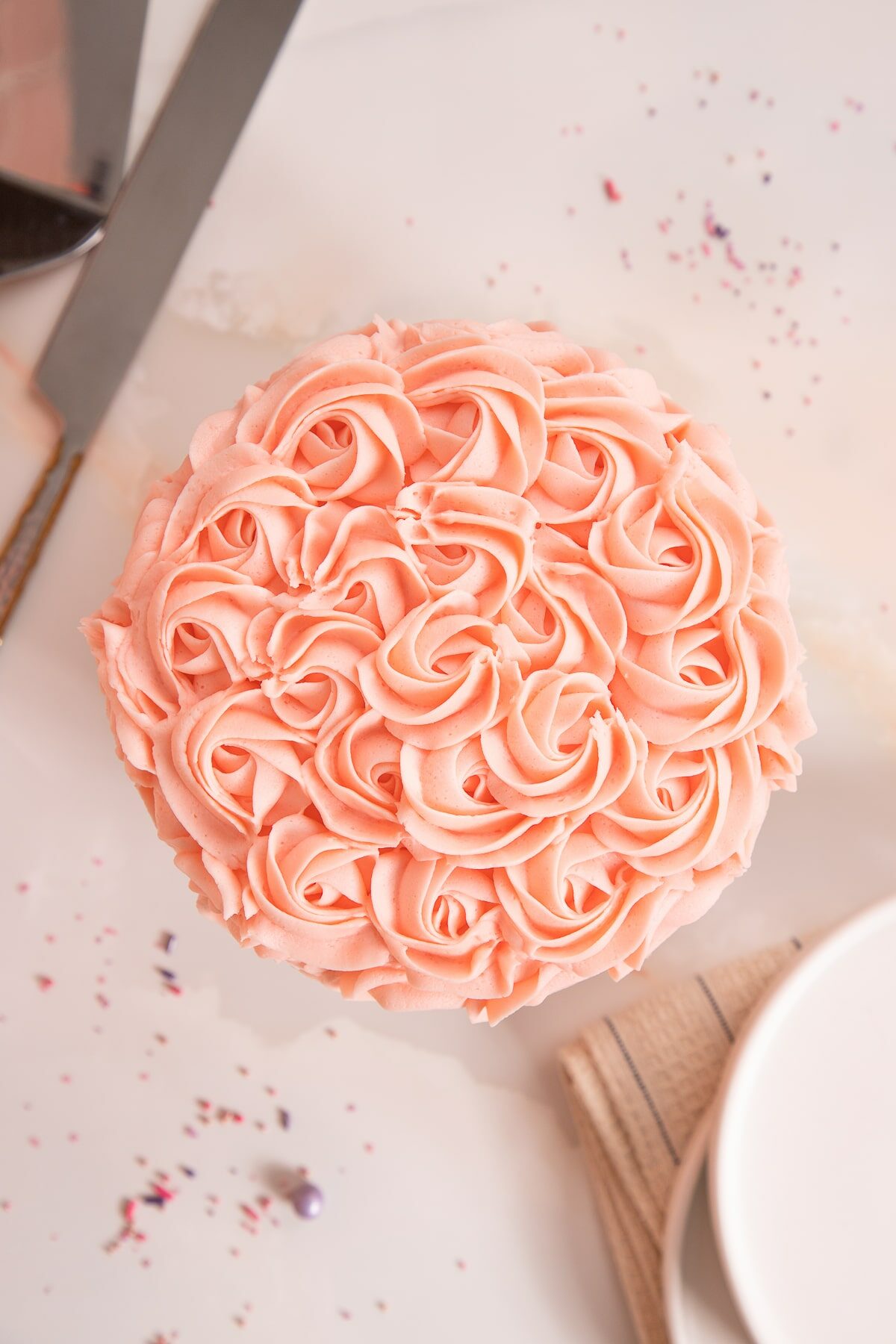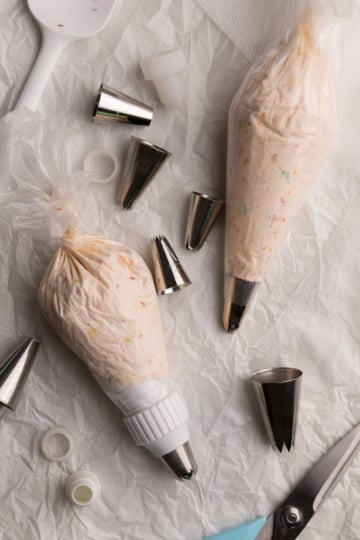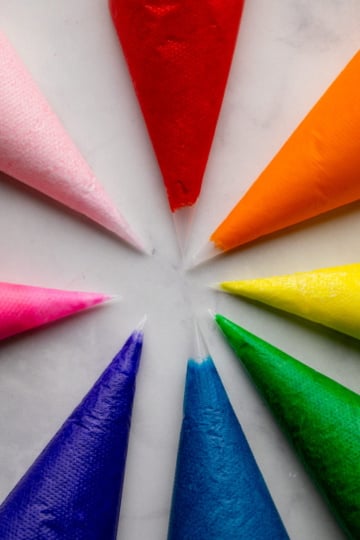This tutorial shows you how to make a rosette cake, which is a beautiful, elegant, and simple cake decorating technique using star piping tips.

Aren't these Rosette cakes pretty? They are such a simple cake decorating technique that is characterized by using star piping tips to pipe buttercream swirls or rosette shapes in a circular pattern on a cake.
The result is a beautiful, elegant cake that is perfect for any so many different occasions – from weddings to birthdays, Valentine's Day to Easter.
And, while you can buy one from $75-100 dollars at a specialty bakery, they are actually really simple to make yourself!
You just need a few easy to find tools, and your favorite cake and frosting recipe.
Ingredients and Tools

- Cake: use your favorite cake recipe.
- Buttercream Frosting: You can use almost any type of buttercream frosting.
- Piping Tips: Large star piping tips such as a Wilton 1M or Ateco 848 work best for piping rosettes.
- Food Coloring (optional): I recommend gel food coloring for more vibrant colors.
- Piping Bags: For holding frosting.
- Cake Decorating Tools (optional): Such as a turntable, scraper, and cake board. These are not necessary but can be helpful if making a rosette layer cake. You can also pipe rosettes onto sheet cakes or cupcakes.
How to Make
Step 1: Fill and Frost Cake

If making a layer cake, bake your cake according to your recipe instructions and let the layers cool completely before starting to frost. If necessary, level your cake layers with a serrated knife or cake leveler.
Apply a bit of frosting to a cake board and add the bottom layer of the cake. Add about ½ cup of frosting and smooth out. Continue with number of layers of cake.
Add a crumb coat of frosting on the cake using a flat spatula. Check out this full tutorial on frosting a layer cake like a professional for tips and tips.
Let chill in the refrigerator for at 20-30 minutes, until the crumb coat is set.
Fill your piping bag with buttercream frosting. It can help to crumb coat with the same color as the rosettes, but it's not necessary.
Step 2: Add Rosettes

To keep the rosettes even, measure the side of the cake using a ruler and divide by the number of rosette layers you'd like. Most cakes typically have two or three, but taller cakes might have four.
Then, make a small dot with a knife at each interval. So, if the cake is 6 inches tall and you're making 3 layers of rosettes, go around and make marks at 2 inches and 4 inches along the side of the cake. Do this in on both sides of the cake, or even marking all around the cake to keep the rosettes even.
Fit a medium piping bag with the desired star tip. The add about 1-2 cups of buttercream frosting. If you’ve never piped rosettes before, I recommend practicing on a piece of parchment paper or silicone mat until you get the hang of it.
How to pipe rosettes on a cake:
- Hold the piping bag at a 90 degree angle from the cake.
- Apply a fair amount of pressure to the piping bag so a frosting star starts to form.
- Then, while still adding pressure to the piping bag, slowly drag the piping bag around the formed star in a circular motion.
- The more times you go around in a circle the larger the rosette will be. For classic rosette cakes going around once is common.
- Slowly let up on the amount of pressure when ending the rosette.
- To keep the cake looking clean, pipe all the rosettes in the same direction. For example, if the first rosette is piped clockwise, continue piping all rosettes clockwise.
- It also helps to try to stop the rosettes in the same spot, for example on the right hand side. Then, starting the new rosette to overlap the tail end of the last rosette keeps for a clean looking cake as well.
Continue piping rosettes all around the sides of the cake and then piping around the top. Add more frosting to the piping bag as needed. That’s it! A beautiful and elegant cake that looks like it took much more time and effort than it actually did.
Tips and Tricks
- Smooth out any air bubbles in your frosting by mixing with a paddle attachment on the lowest setting for 3-5 minutes, or using a rubber spatula to stir out the bubbles. You can even add to a food processor and pulse for a few seconds. The heat helps to get rid of the air bubbles.
- If you've never piped rosettes, I recommend practicing on parchment or a silicone mat. You can also try different tips and see which one you like best!
- Measuring along the sides of the cake and making small markings at each layer interval can help keep rosettes layers even.
- It can help to crumb coat with the same color as the rosettes, but it's not necessary. Just know you might see small spots of crumb coat between the rosettes, so plan accordingly.
- Gel food coloring keeps colors vibrant without altering the consistency of the frosting.
- Do not overfill the bag of frosting. If the frosting gets too warm in our hands, the edges of the rosettes will look sloppy and droopy. Using a small amount of frosting and refilling the piping bag as necessary keeps the frosting at the right temperature and consistency, plus it is easier to control the piping.
- Piping all the rosettes in the same direction and stopping the rosettes on the same side help keep the cake looking clean and uniform.
- Rosette cakes do not need to be layer cakes, you can use this same rosette piping technique on sheet cakes and cupcakes.

FAQ
The most common piping tip for rosettes is the Wilton 1M, but really any type of open or closed star tip, or drop flower tip will work! Other common tips include:
Wilton 2D
Ateco 824
Ateco 34
You can also uses smaller star tips for mini layer cakes, cupcakes, or for alternate size rosettes for sheet cakes.
Buttercream frosting works best for this type of decorated cake. American buttercream, Italian meringue buttercream, Swiss meringue Buttercream all work. Even ermine frosting or cream cheese frosting will work, provided they are not too soft.
You want a medium consistency buttercream that is firm enough to fold it shape when piped and not spread, but soft enough that the edges remain smooth and pretty. Chilling the frosting for 15-20 minutes before piping and not overfilling the piping bag with frosting can help.
While homemade frosting works best for this type of cake, there are a few tips if you decide to use a store bought frosting instead:
Whip the pre-made frosting for a few minutes prior to piping. Start on high until it increases in size, about 2-3 minutes. Then, whip on the lowest speed for 3-5 minutes to help remove any air bubbles. Adding ¼ to ½ cup of powdered sugar while whipping the frosting will thicken it up to a piping consistency even more.
Chill the whipped frosting 15-20 minutes before piping to help firm it up to the correct consistency.
Using different shades of the same color frosting for each layer of rosettes will create a nice ombre effect on the cake. Using gel food coloring helps keep the colors vibrant without altering the consistency of the frosting.
Make Ahead and Storing
Like most buttercream cakes, they can made ahead and stored at room temperature for 1-2 days (provided there is no filling or garnishes that needs to be refrigerated) or in an extra large plastic cake container in a refrigerator for up to 5 days.
The cake can also be frozen up to a month. Defrost and let come to room temperature before serving.
Looking or more cake decorating techniques? Check these out!

WANT TO JOIN THE PARTY? Subscribe to my newsletter and follow on Tik Tok, Pinterest, Instagram, and Facebook for all the latest recipes!

How to Make a Rosette Cake
Equipment
INGREDIENTS
- 1 Cake baked and cooled
- 6-8 cups Buttercream Frosting depending on size of cake
- Food Coloring optional
Instructions
- Bake cake layers according to instructions and let cool completely.
- If necessary, level cake layers with a serrate knife or cake leveler.
- Apply a bit of frosting on cake board of cake stand and place the add the bottom layer of cake.
- Add about ½ cup for frosting and smooth it out using an offset spatula or knife.
- Continue adding cake layers and frosting.
- Add a crumb coat of frosting and smooth it out using an offset spatula.
- Chill the cake in the refrigerator for 20-30 minutes until the crumb coat is set.
Piping Rosettes on a Cake
- If desired, measure the sides of the cake using a ruler and divide by the number of rosette layers you'd like.
- Then make small markings in the frosting at each interval with a knife so that when you pipe you can keep the rosettes even.
- Add 1-2 cups for buttercream frosting to a piping bag fitted with the desired star tip.
- Hold the piping bag at a 90 degree angle from the cake.
- Apply a fair amount of pressure to the piping bag so a frosting star starts to form onto the cake.
- Then, without lifting and while still adding pressure to the piping bag, slowly drag the piping bag and around the formed star in a circular motion.
- For classic rosette cakes going around once is common, but the more times you go around in a circle the larger the rosette will be.
- Slowly let up on the amount of pressure when ending the rosette.
- Make sure to pipe in the same direction and try to stop in the same spot for each rosette. This keeps the cake looking clean.
- Continue piping around the sides of the cake and then on the top of the cake until covered, filling the bag with new frosting as needed.
- Enjoy immediately or store cake in the refrigerator up to 5 days until ready to serve. Let come to room temperature before serving and enjoy!
Notes
- If you've never piped rosettes, I recommend practicing on parchment or a silicone mat. You can also try different tips and see which one you like best!
- It can help to crumb coat with the same color as the rosettes, but it's not necessary. Just know you might see small spots of crumb coat between the rosettes, so plan accordingly.
- Gel food coloring keeps colors vibrant without altering the consistency of the frosting.






Sophia Assunta says
I hope you love this tutorial! Check out more user reviews (and pictures of readers’ rosette cakes!) on this Rosette Cake Tutorial Pin on Pinterest!